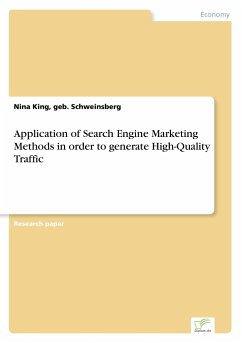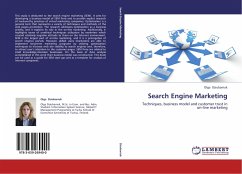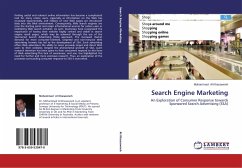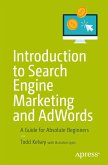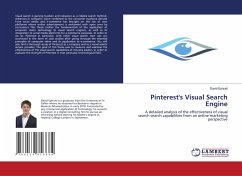Scholarly Research Paper from the year 2006 in the subject Business economics - Marketing, Corporate Communication, CRM, Market Research, Social Media, grade: 1,0, University of Applied Sciences Offenburg (Studiengang Medien und Informationswesen), language: English, abstract: Inhaltsangabe:Abstract:
In a time of tightening budgets, rising bankruptcies and heightened job insecurity, all commerce, be it a major corporation or simply that of a sole operator, must improve its ROI (Return On Investment) rate in order to ensure its continued sustainability. This factor is the key performance indicator (KPI) for any business.
The goal of improved ROI becomes all the more difficult when comparing the effectiveness of competing marketing strategies because intangible factors in the purchasing decision such as brand awareness as well as product credibility and loyalty cannot be easily quantified. Even the consumer often has an unconscious preference for one particular product over another. In this regard online marketing offers the advantage of the pull-principle: the user, who pulls the information that he/she is seeking for directly from the Internet, initiates all activities. This implies that a relationship is established between the corporation and consumer.
With 90 percent of all Internet users choosing to access a SE during a given session, this first point of contact becomes often decisive in the success or failure for the online marketing concept. Nevertheless, there is an inter-dependency between both the attractiveness and the ability to locate a website, i.e. its findability . A website s content may be highly interesting and appropriate to the user s needs but it will be condemned to failure if it cannot be correctly sourced (i.e. ranked) by a SE. Be that as it may, every top ranked website will be rejected if content and usability disappoint expectations.
This report intends to show how Search Engine Optimization (SEO) can be used in a strategic context as the first part of the lead process. SEO highlights the importance of keyword decisions in order to attract customers who secure high conversion rates and thus increase sales, be it online or offline.
The first part of this analysis will explain the technical background of how SEs and keywords work. Also, there are several influential factors that should be considered when optimizing keywords for one s business, such as SE algorithms, the SE market, the consumer and his position in the buying cycle as well as online competitors. These aspects are discussed in the second part of this analysis. The final part will present the concept of Online Performance Measurement & Management (OPMM) and demonstrate how Search Engine Marketing (SEM) can affect a business overall ROI.
Inhaltsverzeichnis:Table of Contents:
KurzdarstellungII
AbstractIII
AbbreviationsIV
1.Introduction and Overview1
2.Search Engine Marketing - Definitions and Technical Background3
2.1Search Engine Marketing (SEM)3
2.1.1Delineation of SEO from SEM4
2.2Organic Search Optimization4
2.2.1SE Technology5
2.2.2On-Page Measures9
2.2.3Off-Page Measures13
2.3Paid Search Advertising15
2.3.1Paid Inclusion15
2.3.2Paid Placement16
2.3.3Directory Submission17
2.4Unethical Search Optimization18
2.4.1Spamdexing18
2.4.2Link Spam19
3.Factors Influencing Keyword Decision21
3.1SE Market21
3.1.1SE Market22
3.1.2Trends24
3.2Online Competitors25
3.2.1Keyword Benchmark26
3.2.2Website Benchmark27
3.3Target Group and SE User Behaviour30
3.3.1General User Attitude towards SEs30
3.3.2SETraffic and the buying cycle32
4.SEM within Online Performance Management36
4.1Classification of Online Performance Management (OPM)36
4.1.1Performance Measurement and Sales Funnel Concept37...
In a time of tightening budgets, rising bankruptcies and heightened job insecurity, all commerce, be it a major corporation or simply that of a sole operator, must improve its ROI (Return On Investment) rate in order to ensure its continued sustainability. This factor is the key performance indicator (KPI) for any business.
The goal of improved ROI becomes all the more difficult when comparing the effectiveness of competing marketing strategies because intangible factors in the purchasing decision such as brand awareness as well as product credibility and loyalty cannot be easily quantified. Even the consumer often has an unconscious preference for one particular product over another. In this regard online marketing offers the advantage of the pull-principle: the user, who pulls the information that he/she is seeking for directly from the Internet, initiates all activities. This implies that a relationship is established between the corporation and consumer.
With 90 percent of all Internet users choosing to access a SE during a given session, this first point of contact becomes often decisive in the success or failure for the online marketing concept. Nevertheless, there is an inter-dependency between both the attractiveness and the ability to locate a website, i.e. its findability . A website s content may be highly interesting and appropriate to the user s needs but it will be condemned to failure if it cannot be correctly sourced (i.e. ranked) by a SE. Be that as it may, every top ranked website will be rejected if content and usability disappoint expectations.
This report intends to show how Search Engine Optimization (SEO) can be used in a strategic context as the first part of the lead process. SEO highlights the importance of keyword decisions in order to attract customers who secure high conversion rates and thus increase sales, be it online or offline.
The first part of this analysis will explain the technical background of how SEs and keywords work. Also, there are several influential factors that should be considered when optimizing keywords for one s business, such as SE algorithms, the SE market, the consumer and his position in the buying cycle as well as online competitors. These aspects are discussed in the second part of this analysis. The final part will present the concept of Online Performance Measurement & Management (OPMM) and demonstrate how Search Engine Marketing (SEM) can affect a business overall ROI.
Inhaltsverzeichnis:Table of Contents:
KurzdarstellungII
AbstractIII
AbbreviationsIV
1.Introduction and Overview1
2.Search Engine Marketing - Definitions and Technical Background3
2.1Search Engine Marketing (SEM)3
2.1.1Delineation of SEO from SEM4
2.2Organic Search Optimization4
2.2.1SE Technology5
2.2.2On-Page Measures9
2.2.3Off-Page Measures13
2.3Paid Search Advertising15
2.3.1Paid Inclusion15
2.3.2Paid Placement16
2.3.3Directory Submission17
2.4Unethical Search Optimization18
2.4.1Spamdexing18
2.4.2Link Spam19
3.Factors Influencing Keyword Decision21
3.1SE Market21
3.1.1SE Market22
3.1.2Trends24
3.2Online Competitors25
3.2.1Keyword Benchmark26
3.2.2Website Benchmark27
3.3Target Group and SE User Behaviour30
3.3.1General User Attitude towards SEs30
3.3.2SETraffic and the buying cycle32
4.SEM within Online Performance Management36
4.1Classification of Online Performance Management (OPM)36
4.1.1Performance Measurement and Sales Funnel Concept37...

